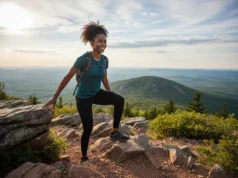In this article
The scrape of fabric on granite, the sting of wind on a high ridge, the splash of an unexpected creek crossing—your mens pants hiking are your first line of defense and your primary tool for mobility on the trail. But the wrong pair can turn an epic adventure into a miserable slog of chafing, overheating, or shivering. This guide cuts through the noise, providing a field-tested framework to help you choose the perfect mens hiking pants—not just for any trail, but for your trail, whether thats a dusty trek through the Sonoran Desert or a scramble in the Alaskan backcountry. We go beyond simple specs to help you learn the why behind the what, understanding how material, stretch, and construction translate directly to on-trail performance. Well introduce you to three core hiker “personas,” allowing you to pinpoint your exact needs and avoid buying a pant built for someone elses adventure. With our field-tested recommendations for hikers, from the rugged bushwhacking pro to the ultralight thru-hiker, youll be able to make a confident choice and invest in gear that will last for seasons to come.
How to Choose the Right Mens Hiking Pants: An Experts Framework
As an instructor who has spent countless days in the mountains, Ive seen firsthand how the right gear can make or break an experience. This section is designed to arm you with the objective knowledge needed to make a smart, confident choice, transforming you from a passive consumer into an informed gear analyst ready to assess any pair of hiking trousers or mens trekking pants.
Why Do Comfort & Mobility Matter More Than Anything?
On a long day, discomfort is more than an annoyance; its a liability. It leads to distraction, which can lead to fatigue, which ultimately compromises safety. The foundation of on-trail comfort is mobility, and this is engineered directly into the fabric and design of a pant. The “Anatomy of Mobility” begins with the material itself. Look for a high spandex or elastane content, typically between 4% and 15%, which enables the stretch fabric to move with your body in either two or four directions. But material is only half the battle. The true magic lies in the construction.
A gusseted crotch, that small diamond-shaped panel of fabric sewn into the inseam, is a non-negotiable feature for technical climbing or high-stepping. It replaces the restrictive point where four seams would normally meet, dramatically increasing your legs range-of-motion for getting over logs or scrambling up rock. Similarly, articulated knees, created by adding darts or extra seams to create a pre-bent shape, prevent the fabric from binding and pulling tight every time you lift your leg. These two features, working in concert, are the difference between a pant that fights you and a pant that feels like a second skin. They are the core of building a complete hiking clothing system where every piece works together. You can find more details on these fundamentals from authoritative sources like REIs Expert Advice. But ease of movement is useless if the pants fall apart after one season.
How Do I Balance Durability with Weight?
Here lies the fundamental trade-off in outdoor gear: ruggedness almost always comes at the cost of higher weight (oz) and lower breathability. Your mission dictates where you fall on this spectrum. The cornerstone of durability in hiking pants is Nylon. This synthetic fiber provides exceptional abrasion resistance and tensile strength, making it the go-to choice for gear that needs to withstand punishment. For the most extreme use cases, youll find materials like Fjallravens G-1000 fabric, a hyper-durable, workwear-grade fabric blend of polyester and cotton that feels nearly indestructible. To smartly add toughness without adding weight everywhere, high-end pants feature reinforced knees and a reinforced seat—the areas that see the most abuse. A pants weight is a direct indicator of its intended purpose. A lightweight hiking pant under 12 ounces is engineered for ultralight backpacking, while a pant over 16 ounces is likely a rugged workhorse built for demanding, off-trail use. Once youve chosen your durability level, the next step is to understand how it will protect you from the elements.
| Feature | Synthetics (Nylon/Spandex) | Cotton |
|---|---|---|
| Durability | Excellent abrasion resistance and tensile strength. | Fair (prone to wear and tear). |
| Drying Time | Very fast; wicks moisture efficiently. | Very slow; absorbs and holds onto moisture. |
| Breathability (Wet) | Retains some breathability even when damp. | Becomes heavy and stops breathing when wet. |
| Safety in Cold | Maintains insulating properties when damp, reducing risk. | ⚠️ Danger: Loses all insulation when wet, leading to a high risk of hypothermia. |
Whats the Difference Between Weather Resistance and Breathability?
This is the critical “push-pull” of pant performance. You need to block external weather like wind and rain while simultaneously venting internal moisture—your sweat. The primary defense against light precipitation is a Durable Water Repellent (DWR) finish. This is a chemical coating applied to the fabrics exterior that causes water to bead up and roll off instead of soaking in. Wind Resistance is a function of the fabrics tight weave, physically blocking more wind from passing through, a key feature of softshell pants like the Arcteryx Gamma—ideal for an exposed alpine ridge.
The other side of the coin is Breathability, which is the fabrics ability to allow sweat vapor to escape. This is crucial for preventing the “flash-off” chilling effect that happens when you stop moving and the trapped sweat rapidly cools you down. Here, the trade-off is direct: a more open-weave, highly breathable fabric like that found in the Outdoor Research Ferrosi pants will be inherently less weather-resistant, though perfect for hot weather or summer hiking. To solve this, many heavy-duty pants incorporate mechanical ventilation, like zippered thigh vents, allowing you to manually dump a massive amount of heat when youre working hard without sacrificing the pants overall protective qualities.
Pro-Tip: DWR isnt permanent. After a season of use and washing, youll notice water starting to “wet out” the fabric. You can easily refresh it at home with a technical wash-in or spray-on DWR treatment, like those from Nikwax or Grangers, to restore your pants to their original performance.
Which Features Actually Make a Difference on the Trail?
Beyond the core construction, a few smart features can elevate a good pant to a great one. The single most important feature, in my experience, is a well-placed zippered thigh pocket. It must be positioned so it remains fully accessible even when youre wearing a backpack with a cinched hip belt, providing a secure spot for a map, phone, or snacks. Another game-changer is an integrated belt or internal drawcord. These create a low-profile fit that eliminates the pressure points and chafing a bulky, traditional belt buckle can cause under a heavy pack. Down at the ankle, adjustable cuffs, whether via drawcord cuffs or roll-up snaps, are incredibly useful for both ventilating on hot uphills and for sealing out trail debris, mud, and insects, a key element for bug protection. Finally, dont overlook a UPF rating for sun protection. A rating of UPF 50+ is the gold standard sun-protective fabric, blocking over 98% of harmful UV radiation—a critical safety feature for long days above treeline or on the Appalachian Trail in summer. The rise of “trail-to-town” aesthetics is also a valid consideration, as a pant that looks good in a casual setting offers far more value for your investment.
Pro-Tip: Before a big trip, put on your pants and the fully loaded backpack you plan to use. Cinch the hip belt tight and walk around. Can you still access the pockets you need? Does the waistband bunch up or create a pressure point? This simple five-minute test at home can save you a full day of misery on the trail.
Our Selection Process: How We Built This Guide
Our commitment is to absolute objectivity. We arent here to just list popular products; our mission is to provide a data-driven framework that empowers you to find the right product for your specific needs. This guide is built on a foundation of independent testing data, countless hours of field use, and expert analysis from across the outdoor apparel world.
Every pant in this guide was rigorously scored against the five critical performance pillars weve just discussed: Comfort & Mobility, Durability, Weather Resistance, Breathability, and Features. Our selection process is two-fold. First, we identify the core “Hiker Personas”—the distinct types of users in the market with unique demands.
Second, we curate the top-performing pants that are precision-engineered to meet each personas mission, ensuring every recommendation is a targeted solution, not just another item on a list.
If you choose to buy through a link on this page, we may earn a small commission at no extra cost to you. This directly funds our independent research and testing, and we only recommend gear we genuinely believe in.
The Best Mens Hiking Pants of 2025: Our Top Recommendations for Every Need
Now that youre armed with the knowledge to assess a pants design, its time to meet our top picks. Weve categorized them by hiker persona, allowing you to zero in on the gear thats truly built for your adventures, from casual day hiker to dedicated backpacker.
Our Top Picks for “The Rugged Backcountry Professional”
This hiker is defined by their environment. They prioritize bombproof durability and absolute protection over low weight because their adventures take them off-trail, through dense brush, and into harsh, abrasive mountain terrain. For them, gear failure is not an option. They need a workhorse pant that can withstand serious abuse in cold weather where scraping against rock and thorns is the primary enemy.
Our Top Picks for “The All-Conditions Thru-Hiker”
This hiker measures their trips in weeks or months, not days. Their primary concerns are minimizing weight, maximizing all-day comfort, and ensuring their gear is versatile enough to handle a wide range of conditions from sun-baked valleys to windy passes. They need a single, reliable trail pant that breathes exceptionally well, moves without restriction, and is quick-drying after an unexpected storm or river crossing. These are the best adventure pants for long trail miles.
Our Top Picks for “The Weekend Warrior & Traveler”
This is the largest and most diverse group of hikers. They need a single pant that can do it all: perform comfortably on a 10-mile day hiking trip, survive the rigors of air travel, and look good enough for a post-hike brewery stop without screaming “technical gear.” For this user, versatility, comfort, style, and overall value are the most important metrics, making these ideal camping pants mens can rely on.
Conclusion
The most crucial takeaway is that the “best” hiking pants dont exist in a vacuum; they exist for a mission. The best pairs are always crafted from synthetic blends like nylon and spandex, which provide that critical balance of durability, stretch, and moisture wicking that cotton can never offer. Remember that true mobility comes from smart design—a gusseted crotch and articulated knees are non-negotiable features for unrestricted movement on technical terrain. The most important step you can take is to honestly assess your primary hiking style. A lightweight hiking pant built for a thru-hiker is simply the wrong tool for a bushwhacker who needs heavy, durable protection, and vice versa. Finally, look for those smart features like a zippered thigh pocket thats accessible with a hipbelt on, an integrated low-profile belt, and a UPF 50+ rating that significantly enhance a pants on-trail utility and safety.
Armed with this expert framework, youre now ready to make an informed choice. Re-evaluate your hiker persona, compare our top picks for your specific needs, and invest in a pair of hiking pants that will become a trusted partner on all your adventures to come.
Frequently Asked Questions about Mens Hiking Pants
What is the best material for hiking pants?
The best materials are synthetic blends, most commonly a combination of nylon for its exceptional durability and spandex (also called elastane) for its critical stretch. These fabrics are superior for outdoor use because they are strong, resist abrasion from rock and brush, and are hydrophobic, meaning they dont absorb water. This allows them to manage sweat effectively and dry very quickly after a rain shower, which is vital for both comfort and safety. You should avoid cotton, and especially hiking pants vs jeans, as denim absorbs moisture, loses all insulating properties when wet, and can lead to dangerous hypothermia.
Are expensive hiking pants really worth it?
Yes, in many cases, premium hiking pants are worth the investment, especially if you need specialized performance for a demanding activity. The higher price typically pays for more advanced materials that offer a better stretch-to-durability ratio, superior DWR treatments for weather resistance, and more complex construction techniques like welded seams or intricate paneling. A premium pant like the Arcteryx Gamma, for example, has a more refined, athletic fit that is meticulously designed to move with your body during technical climbing, an advantage you can truly feel and appreciate when performance is critical.
What do I need to know about UPF ratings in pants?
A UPF (Ultraviolet Protection Factor) rating indicates how much UV radiation a fabric allows to reach your skin. A UPF 50+ rating is considered the gold standard for sun-protective clothing, as it blocks over 98% of harmful UVA and UVB rays. This is a critical safety feature for anyone hiking in exposed, high-altitude, or desert environments where sun exposure is intense. It provides far more reliable and consistent protection than sunscreen, which can wear or sweat off. For maximum protection, look for this high rating on products like the Outdoor Research Ferrosi or prAna Stretch Zion.
What are the most important functional features in a hiking pant?
From a functional standpoint, the three most critical features are a gusseted crotch and articulated knees for mobility, and at least one zippered thigh pocket that remains accessible while youre wearing a backpack. The gusset and articulation provide the freedom of movement necessary for climbing and navigating obstacles. The thigh pocket ensures you have a secure place for essential items that you can get to without having to remove your pack. An integrated, low-profile belt is another highly valued feature, as it provides a secure, adjustable fit without creating painful pressure points under your packs hip belt.
Risk Disclaimer: Hiking, trekking, backpacking, and all related outdoor activities involve inherent risks which may result in serious injury, illness, or death. The information provided on The Hiking Tribe is for educational and informational purposes only. While we strive for accuracy, information on trails, gear, techniques, and safety is not a substitute for your own best judgment and thorough preparation. Trail conditions, weather, and other environmental factors change rapidly and may differ from what is described on this site. Always check with official sources like park services for the most current alerts and conditions. Never undertake a hike beyond your abilities and always be prepared for the unexpected. By using this website, you agree that you are solely responsible for your own safety. Any reliance you place on our content is strictly at your own risk, and you assume all liability for your actions and decisions in the outdoors. The Hiking Tribe and its authors will not be held liable for any injury, damage, or loss sustained in connection with the use of the information herein.
Affiliate Disclosure: We are a participant in the Amazon Services LLC Associates Program, an affiliate advertising program designed to provide a means for us to earn advertising fees by advertising and linking to Amazon.com. As an Amazon Associate, we earn from qualifying purchases. We also participate in other affiliate programs and may receive a commission on products purchased through our links, at no extra cost to you. Additional terms are found in the terms of service.





